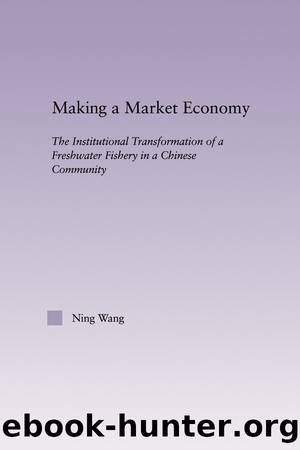Making a Market Economy by Wang Ning;

Author:Wang, Ning;
Language: eng
Format: epub
Publisher: Taylor & Francis Group
Introduction
I conducted an ethnographic field study at a Chinese fishing firm at Wenâs Village (hereafter WV) in Jingmen County, Hubei province. WV is a natural village, stretching along the eastside shore of Wenâs Bay, a part of Longlake, see figure 3.2 on p. 48. Wenâs Bay, approximately 5 kilometers long and 2 kilometers wide, serves as a reservoir for paddy fields around and also a fishing site for nearby villagers.
WV consists of 38 households, with a total population of 176 (1998 statistics). Like other villages in this region, rice is the main crop. In the pre-reform era, WV was organized as a âproduction team,â collectively cultivating paddy fields. Village cadres, who came from the village and were politically correct and active, were responsible for managing collective agriculture and supervising general village affairs as well (c.f., Schurmann 1968; Parish and Whyte 1978; Chan, Madsen, and Unger 1984; Potter and Potter 1990). Villagers were paid primarily in rice according to their accumulated yearly âwork points,â which were recorded daily by cadres. Though collective agriculture provided the primary source of livelihood for villagers, each household also engaged in various âsideline productionsâ to strengthen self-sufficiency, raising chicken and pigs, planting vegetables on its private plots, as well as fishing in Wenâs Bay. However, the scale of sideline productions was quite limited. It bears noting that the subsistence village economy in the collective era had a dual organizational feature. One the one hand, peasants collectively organized agriculture to fill their ârice bowls.â On the other hand, each household individually conducted sideline productions to stuff their âvegetable baskets.â
This dual structure of village economy collapsed, however, after the household responsibility system was adopted at WV in 1980. Since the introduction of rural economic reforms, agriculture was de-collectivitized. Each household became autonomous and wholly responsible for its allotted rice fields as well as sideline productions. Unlike villages in coastal areas with thriving village enterprises, WV had no rural industry at all (compare Huang 1998). As a result, the demise of collective agriculture and the âproduction teamâ virtually discharged the village as an economic organization from the rural economy (e.g., Watson 1985; Nee and Su 1990). Without any other organizations active in the village, the household became the only visible player. Like other rural areas in the reform era, âhousehold individualismâ has taken firm hold in every aspect of the village life (e.g., Nee 1985).
The rise of household individualism does not, however, imply an abject picture of âamoral familismâ as portrayed by Edward Banfield (1967). Despite the decline of village as an economic organization, various communal ties loom large, which help to keep WV a vibrant neighborhood. With restricted mobility, all male household heads have been living in the village for their whole lives. In the past two decades even when political control of mobility was lifted, only two households emigrated out of the village and no case of immigration was reported. This lack of âexitâ helps to cultivate long-term relationships among villagers (c.f. Hirschman 1970). As residents of the same village, they interact with each other directly, frequently and in multi-faceted ways.
Download
This site does not store any files on its server. We only index and link to content provided by other sites. Please contact the content providers to delete copyright contents if any and email us, we'll remove relevant links or contents immediately.
The European History Highway: A Guide to Internet Resources by Dennis A. Trinkle Scott A. Merriman(494)
The Seven Wonders of the Ancient World by Michael Denis Higgins(478)
European Security in a Global Context by Thierry Tardy(470)
European Security without the Soviet Union by Stuart Croft Phil Williams(469)
The Routledge companion to Christian ethics by D. Stephen Long Rebekah L. Miles(458)
Hudud Al-'Alam 'The Regions of the World' - a Persian Geography 372 A.H. (982 AD) by V. V. Minorsky & C. E. Bosworth(399)
Gorbachev And His Generals by William C. Green(391)
Get Real with Storytime by Julie Dietzel-Glair & Marianne Crandall Follis(390)
Tibetan Studies in Comparative Perspective by Chih-yu Shih Yu-Wen Chen(385)
Governance, Growth and Global Leadership by Espen Moe(381)
Hyperculture by Byung-Chul Han(378)
CliffsNotes on Fitzgerald's The Great Gatsby by Kate Maurer(360)
The Oxford History of the World by Fernández-Armesto Felipe;(354)
How Languages Are Learned 5th Edition by Patsy M Lightbown;Nina Spada; & Nina Spada(353)
The Egyptian Economy, 1952-2000 by Khalid Ikram(352)
Oral Poetry and Narratives from Central Arabia: The Poetry of Ad-Dindan : A Bedouin Bard in Southern Najd (Studies in Arabic Literature, Vol 17) (English and Arabic Edition) by P. M. Kupershoek P. Marcel Kurpershoek(345)
The Oxford Handbook of the Incas by Sonia Alconini(333)
Europe Contested by Harold James(320)
The Hutchinson Dictionary of Ancient and Medieval Warfare by Peter Connolly John Gillingham John Lazenby(305)
